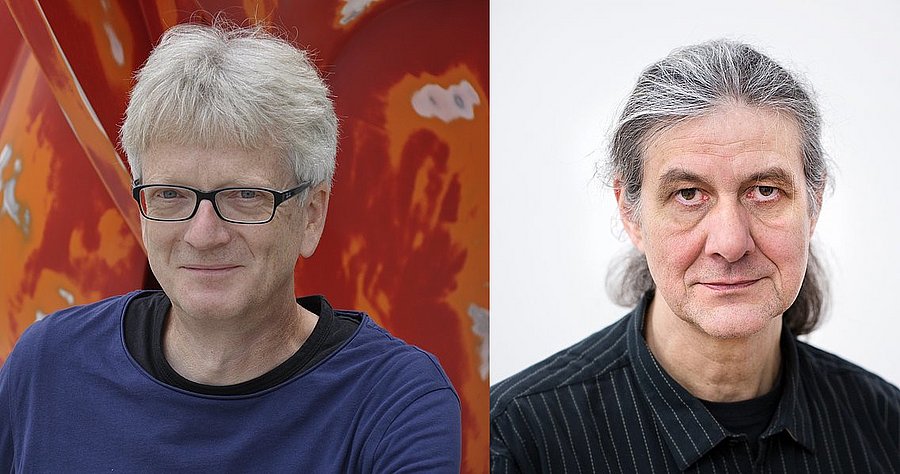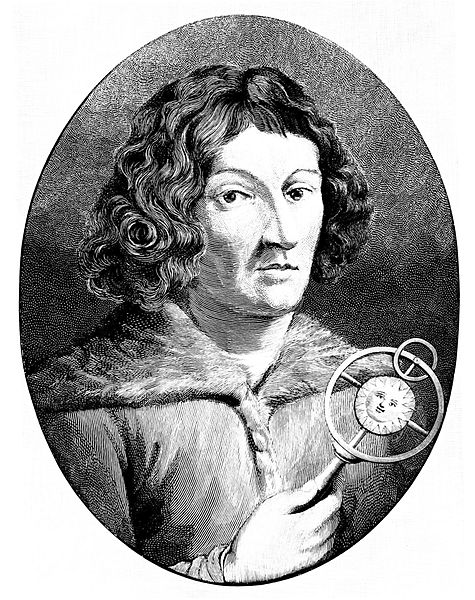
Lecture series on the 550th birthday of Nicolaus Copernicus
Prof. Dr. Volker Remmert / History of Science and Technology
Prof. em. Dr. Gregor Schiemann / Department of Philosophy
Photo: UniService Transfer / Sebastian Jarych
When we were pushed from the center of the cosmos to the edge
Volker Remmert and Gregor Schiemann about the new world view of Nicolaus Copernicus, presented in a lecture series of the IZWT on the occasion of the 550th birthday of the exceptional scientist.
The earth is the center of the universe! Around it orbit the sun, the moon and the other planets, attached to apparently completely transparent crystal spheres. At the outer sphere, finally, the fixed stars are attached... This is probably how the people in the Middle Ages imagined the universe. In 1543, a Pole published in his book 'De Revolutionibus Orbium Celestium' (On the Orbits of the Celestial Bodies) the theory that the Earth revolved around itself and orbited the Sun with the other planets. With it he brought many contemporaries against himself. His name: Nicolaus Copernicus. His theory changed our view of the world. Galileo Galilei, who even then spoke of the Copernican model as reality, was placed under house arrest for nine years from 1633 until his death in 1642. It was not until 1992 that Pope John Paul II fully rehabilitated him. Copernicus' 550th birthday is now being celebrated by the Interdisciplinary Center for Science and Technology Research at Bergische Universität under the leadership of the philosophers Prof. Dr. Anna Leuschner, Junior Prof. Dr. Radin Dardashti, Prof. em. Dr. Gregor Schiemann and the historian Prof. Dr. Volker Remmert in a small series of lectures about this exceptional scientist and the effects of his new world view.
Nicolaus Copernicus (1473 - 1543)
"Copernicus was born in 1473 in Thorn (Torune), which is located in present-day Poland" begins Schiemann. "His father was a wealthy merchant. Little is known about his youth. He studied at Krakow University, and later at Bologna and Padua. In addition to astronomy, he also studied law and medicine, and during his lifetime he was always in demand as a physician. While still a student, he settled in Frauenburg, also in present-day Poland, where he was later appointed canon. He remained in this position throughout his life, had much to do with administrative duties in addition to his astronomical studies, and died in 1543 in Frauenburg, where he was buried in the cathedral there."

Nicolaus Copernicus, Wikimedia, public domain
30 years of research revolutionized the world
Copernicus spent 30 years researching his theory and then waited another 10 years before publishing it. The church could not and would not believe him, because suddenly man was no longer the center of the world. Martin Luther even called him a 'fool' and still years later the Catholic Church forced Galileo Galilei to the statement that the earth does not move. But Copernicus was sure and published his book 'De Revolutionibus Orbium Celestium' in the year of his death in 1543. The long wait before publication, Schiemann explains, was probably not due to fear of church punitive measures, because church representatives, conversely, would even have been interested in his astronomical calculations, which in certain respects were better than the previous ones. Moreover, the distance of the Earth from the center of the universe had been quite compatible with faith, because this place, that is, the center of the universe, unfavorably had the greatest distance from the unchanging sky. "Much more problematic," the scientist continues, "was that the Earth was equal to the other planets in Copernicus` new worldview, opening up the possibility that there might be rational beings on other planets as well." In addition, his calculations showed that the universe would have to be about 400,000 times larger than previously thought and therefore might be provided with the void, which was impermissible in terms of natural philosophy. "Copernicus saw the main advantages of his system in a better compatibility with the metaphysical presupposed also by the church. Among them counted the uniformity of the motion of the planets and the simplification of the premises of the calculation of their orbits." Today it is assumed that Copernicus hesitated so long with publication because he was always dissatisfied with what he had achieved, adding corrections and struggling for a better presentation. "In this respect, he was a typical natural scientist who was not yet satisfied with the body of theory he had," Remmert adds. Even in the preface to his magnum opus, he wisely forewarned of future criticism by declaring that mathematical arguments were precisely written for mathematicians ("mathemata mathematicis scribuntur"). "That's what made him so confident, because he had a method that he knew would give accurate results," Remmert explains. Clerical circles would have had a great interest in astronomy at the time. In Rome, in particular, they knew that the calendar was not working as well as it used to, Remmert describes the situation at the time. "Calendar reform was a big issue, making astronomical models very attractive. Although it took another 40 years to get to the point where the big Gregorian calendar reform came, astronomy was always at the center of religious interest as well; and for all religions."
From heliocentric worldview to geocentric worldview
Copernicus' worldview changed fundamental ideas people had about philosophy and religion and is considered a transition from the Middle Ages to modern times, but it was also received very differently. "Some contemporaries recognized that his system represented a radical break with traditional ideas," Schiemann explains. For example, the poet John Donne wrote in the early 17th century: 'Everything lies in pieces` and Shakespeare, referring to Copernicus, has Hamlet say: 'Truth is a liar`. Still others considered his theory to be mathematical calculations to which no statements about reality could be attached. "Astronomy at that time was considered a mathematical discipline, not a physical one," the philosopher adds. "Because of this difference between mathematics and physics, it is also difficult to determine when Copernicus` findings were fully accepted." The criticism that earth motion was incompatible with Scripture basically began after his death and was codified in the two Galileo Galilei trials that at least the Catholic Church rejected earth motion, Remmert says, adding, "There is a three-stage model by Freud, who spoke of three mortifications. The first is the cosmological mortification. That's what Copernicus inflicts on us because we're pushed from the center of the cosmos to the edge. The biological mortification with Darwin is the second, and the psychological mortification comes with Freud. Seen in this way, Copernicus is at the very beginning of a series of mortifications that make man more and more irrelevant and unspecific." If we add artificial intelligence to the mix for the 21st century, Schiemann formulates, we could perhaps speak of a fourth mortification in the future.
Copernicus' influence on research ...
In 1515 Copernicus was asked to give an opinion for a calendar reform and in 1533 Pope Clement VII had himself informed about his teachings. "Reception set in especially after 1551," Schiemann knows, "after the eminent astronomer Erasmus Reinhold used Copernicus' data to calculate the positions of the heavenly bodies. These Prussian or Prutenian Tables (astronomical tables for calculating the positions of the sun, moon and planets, editor's note), were really the relevant work at the time." It was Galileo's recognition of the heliocentric worldview as a reality, Remmert adds, that made it difficult for the Church to reconcile it with Scripture .
... and the art of his time
"For art, one would perhaps have to say that the dispute about the world views of art was very often thematized" says Remmert. For example, he says, one can look at the famous painting by Andrea Sacchi, the Allegory of Divine Wisdom (1629 - 1633), in a Roman cardinal's palace, where, if one stands under this ceiling fresco, the sun is painted in the center and the earth appears to revolve around the sun. Yet we are in Rome in a supposed center of anti-copernicanism."
Four lectures in four weeks
Since the Interdisciplinary Center with the associated graduate college has rooms in the former Glanzstoffhochhaus, now Teijinhochhaus in Elberfelder City, those responsible use the associated Webersaal for their lectures. The topics are as exciting as they are varied. The prelude will be made on June 14 by co-initiator Prof. Dr. Remmert under the title 'Weltbilder im Widerstreit`. "It is about the dispute of astronomical world views in the 16th and 17th centuries between the geocentric and heliocentric world views," Remmert explains. "And then there are two dates in the title. Copernicus 1543 and 1943. 1543 refers to his publication and 1943 was the 400th anniversary of his publication and also the 400th anniversary of his death. At that time we have the Nazi regime that was covering Europe with war and especially wanted to wipe out Poland as an independent state and its intellectuals. Copernicus is made a German again for ideological reasons. This instrumentalization of a scholar by the National Socialists will be clarified in the lecture." In the other lectures, Ursula Kocher, a German scholar from Wuppertal, will address the topic of `Copernicus and the consequences for literature and art`, historian Arianna Borelli will speak about the three-dimensional models of celestial movements before and after Copernicus, and philosopher of science Martin Carrier will talk about the `achievements and shortcomings of the heliocentric doctrine in its time`.
"The change of worldview is a watershed in human history" Schiemann concludes, "and also has an important metaphorical meaning in other disciplines. It is quite common to speak of a Copernican turn when something is turned upside down or the center is exchanged."
All events (14.06., 21.06., 28.06. and 05.07.) start on Wednesdays at 17.00 in the Webersaal, Kasinostr. 19 - 21, opposite the restaurant `Hans im Glück`. Admission is free.
Further information under: https://www.izwt.uni-wuppertal.de/de/veranstaltungen/ringvorlesung/
Uwe Blass
Prof. Dr. Volker Remmert studied history and mathematics in Freiburg, Zurich and Karlsruhe. He habilitated in Modern and Contemporary History as well as in the History of Mathematics and the Natural Sciences. Since 2011, he has been a professor of the history of science and technology at Bergische Universität. In addition, he heads the Interdisciplinary Center for Science and Technology Studies there.
Prof. em. Dr. Gregor Schiemann taught at the Department of Philosophy of the Faculty of Humanities and Cultural Studies at Bergische Universität until his retirement and is currently co-speaker of the research group "The Epistemology of the Large Hadron Collider".
